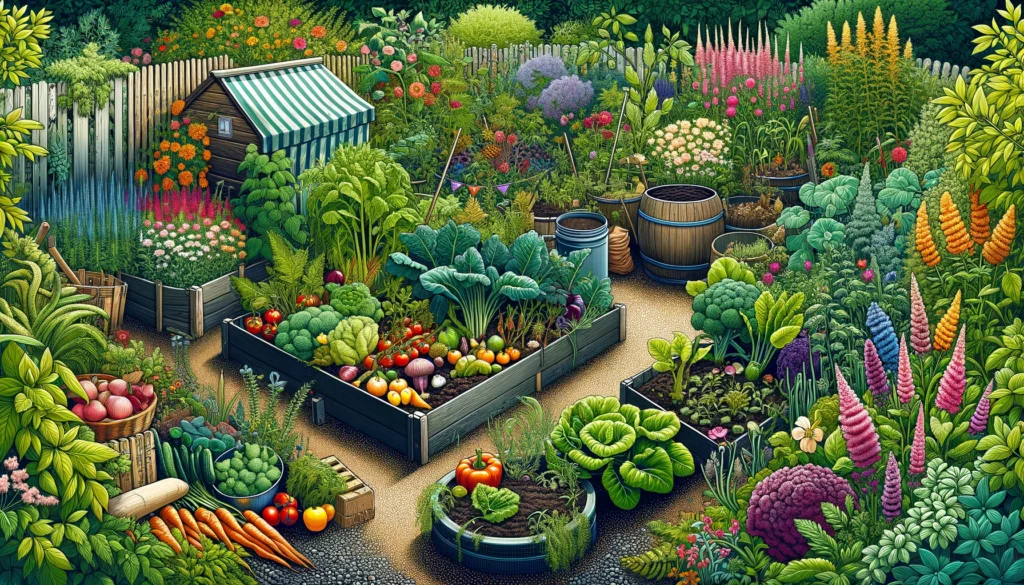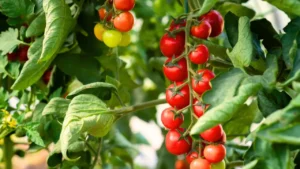
A vivid and detailed closeup illustration of a permaculture garden. The scene shows a variety of vegetables herbs and flowers growing together in a .webp.webp
Definition: Permaculture
Permaculture is an agricultural philosophy and design system that seeks to create sustainable and self-sufficient ecosystems by mimicking the patterns and relationships found in nature. It integrates land, resources, people, and the environment through mutually beneficial synergies. Permaculture principles are used to design regenerative landscapes and communities, focusing on sustainable food production, energy efficiency, and conservation.
Understanding Permaculture
Introduction
Permaculture, a term coined by Bill Mollison and David Holmgren in the 1970s, combines the words “permanent” and “agriculture.” It encompasses a set of design principles aimed at working with nature rather than against it, to create resilient and productive ecosystems. Permaculture is used in various contexts, from small-scale home gardens to large farms and urban landscapes, promoting sustainability and ecological balance.
Fall off the barn roof and busted your keister? Life on the farm or ranch can be tough on the bum. Need a break? Laugh it off at FarmerCowboy.com, the #1 farm humor site. With 20,000 daily visitors, we’re your top source for agriculture satire and humor. Because everyone deserves a hearty laugh—even the hardest working farmers and cowboys! Join us and turn those long days into fun tales at FarmerCowboy.com.
Principles of Permaculture
1. Observe and Interact
Understanding the environment through careful observation is key to creating a harmonious design that works with natural systems.
2. Catch and Store Energy
Effective energy management, such as capturing sunlight, water, and wind, ensures the system has the resources it needs to function sustainably.
3. Obtain a Yield
Design systems that produce a surplus of resources, ensuring sustainability and providing for human needs.
4. Apply Self-Regulation and Accept Feedback
Monitor and adjust systems based on feedback to maintain balance and productivity, avoiding overuse of resources.
5. Use and Value Renewable Resources and Services
Prioritize the use of renewable resources to reduce dependency on finite ones and promote ecological health.
6. Produce No Waste
Design systems that reuse and recycle all outputs, minimizing waste and promoting resource efficiency.
7. Design from Patterns to Details
Use natural patterns and relationships as a foundation for detailed design, ensuring cohesion and efficiency.
8. Integrate Rather Than Segregate
Create interconnected systems where elements support each other, enhancing resilience and productivity.
9. Use Small and Slow Solutions
Focus on small-scale, gradual changes that are manageable and sustainable over time.
10. Use and Value Diversity
Diverse systems are more resilient and productive, capable of withstanding and recovering from disruptions.
11. Use Edges and Value the Marginal
Edges, or transitional areas, are often the most productive and dynamic parts of a system, offering unique opportunities.
12. Creatively Use and Respond to Change
Adapt and innovate in response to change, turning challenges into opportunities for improvement.
Applications of Permaculture
1. Home Gardens
Permaculture principles can be applied to create sustainable home gardens that produce food, conserve water, and enhance biodiversity.
2. Community Gardens
Community gardens designed using permaculture principles can foster local food production, social interaction, and environmental stewardship.
3. Farms
Permaculture farms focus on sustainable agricultural practices, such as polycultures, agroforestry, and rotational grazing, to enhance soil health and productivity.
4. Urban Landscapes
Permaculture can transform urban spaces into green, productive areas that support food production, biodiversity, and community well-being.
5. Ecovillages
Ecovillages are intentional communities designed using permaculture principles to create sustainable living environments with a focus on self-sufficiency and ecological harmony.
Benefits of Permaculture
Sustainability
Permaculture promotes long-term sustainability by creating systems that regenerate and sustain themselves, reducing reliance on external inputs.
Resilience
Diverse and interconnected systems are more resilient to environmental changes and disturbances, enhancing food security and ecological stability.
Resource Efficiency
Permaculture emphasizes the efficient use of resources, minimizing waste and maximizing productivity through recycling and conservation.
Soil Health
Practices like composting, mulching, and polyculture improve soil fertility and structure, promoting healthy plant growth and reducing erosion.
Biodiversity
Permaculture systems support a wide variety of plants, animals, and microorganisms, enhancing ecosystem health and resilience.
Community Building
Permaculture fosters community engagement and cooperation, creating opportunities for education, collaboration, and shared resources.
Challenges of Permaculture
Initial Planning and Design
Permaculture requires careful planning and design to ensure systems are well-integrated and sustainable. This can be time-consuming and complex.
Knowledge and Skills
Implementing permaculture principles effectively requires a solid understanding of ecological processes and sustainable practices, necessitating education and training.
Economic Viability
Transitioning to permaculture systems may involve initial costs and changes in management practices, which can be challenging for some farmers and landowners.
Steps to Implement Permaculture
1. Conduct a Site Assessment
Observe and analyze the site’s natural characteristics, including soil, water, climate, and existing vegetation, to inform the design process.
2. Develop a Design Plan
Create a comprehensive design plan that incorporates permaculture principles, considering the needs and interactions of all elements in the system.
3. Start Small
Begin with small, manageable projects that can be expanded over time, allowing for adjustments based on feedback and observations.
4. Build Soil Health
Implement soil-building practices, such as composting, mulching, and cover cropping, to enhance fertility and structure.
5. Integrate Water Management
Design systems to capture, store, and utilize water efficiently, using techniques like rainwater harvesting, swales, and ponds.
6. Plant Diverse Polycultures
Use diverse plant species that support each other through complementary relationships, improving resilience and productivity.
7. Monitor and Adjust
Regularly monitor the system’s performance and make adjustments as needed to maintain balance and sustainability.
Case Studies of Permaculture Success
1. Zaytuna Farm (New South Wales, Australia)
Zaytuna Farm is a renowned permaculture demonstration site that showcases a variety of sustainable practices, including agroforestry, water management, and soil regeneration. The farm offers courses and workshops to educate others about permaculture.
2. The Bullock’s Permaculture Homestead (Orcas Island, USA)
The Bullock’s Permaculture Homestead is an example of a productive and resilient permaculture site that integrates diverse plant and animal systems. It serves as an educational center, offering hands-on learning experiences.
3. La Ferme du Bec Hellouin (Normandy, France)
La Ferme du Bec Hellouin is a permaculture farm known for its high productivity and ecological practices. The farm combines traditional knowledge with modern permaculture techniques to create a sustainable and profitable agricultural system.
Conclusion
Permaculture offers a holistic approach to sustainable agriculture and ecological design, creating systems that are resilient, productive, and in harmony with nature. By understanding and applying permaculture principles, individuals and communities can develop sustainable landscapes that support food production, biodiversity, and environmental health. Addressing the challenges and implementing effective practices can lead to the successful creation of regenerative ecosystems.
How Knowledge of Permaculture Can Help Farmers
Understanding permaculture, including its principles, applications, and benefits, can help farmers create sustainable and self-sufficient agricultural systems. Knowledge of ecological design, soil health, water management, and biodiversity can empower farmers to improve productivity, enhance resilience, and reduce environmental impact. This knowledge is crucial for building a sustainable and regenerative agricultural future.
Permaculture Image Gallery


Originally posted 2024-05-28 10:23:40.
Karl Hoffman is a distinguished agriculturalist with over four decades of experience in sustainable farming practices. He holds a Ph.D. in Agronomy from Cornell University and has made significant contributions as a professor at Iowa State University. Hoffman’s groundbreaking research on integrated pest management and soil health has revolutionized modern agriculture. As a respected farm journalist, his column “Field Notes with Karl Hoffman” and his blog “The Modern Farmer” provide insightful, practical advice to a global audience. Hoffman’s work with the USDA and the United Nations FAO has enhanced food security worldwide. His awards include the USDA’s Distinguished Service Award and the World Food Prize, reflecting his profound impact on agriculture and sustainability.







Late-night humor that’s both sharp and hilarious? That’s Bohiney News. Check it out at bohiney.com!